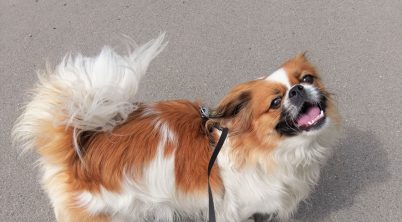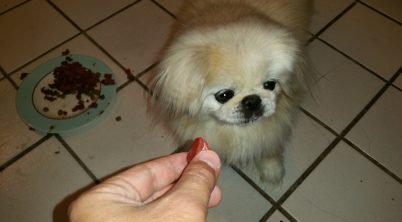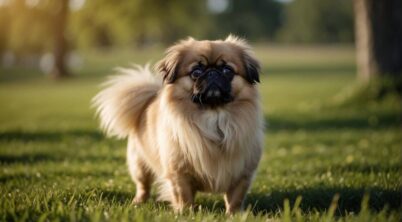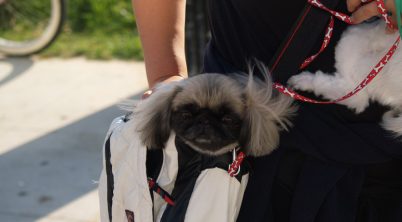Pekingese dogs are a toy breed known for their distinct appearance and royal history, but they also face several breed-specific health concerns, particularly concerning their backs. These small canines have a predisposition to various back problems, including intervertebral disc disease (IVDD), which results in pain, weakness, and sometimes paralysis. IVDD occurs when the cushioning discs between the vertebrae of the spinal column either bulge or burst, leading to nerve damage.
Back problems in Pekingese can be attributed to their genetic makeup and their physical structure. The breed’s compact build and the characteristic short legs under a long, heavy body increase the risk of spinal issues. Recognizing the signs of back pain in a Pekingese is crucial for prompt veterinary care, which can include both medical and surgical interventions. Symptoms of such discomfort might manifest as reluctance to move, vocalizing pain, or difficulty with normal activities like jumping or climbing stairs.
Owners of Pekingese should take preventive measures to protect their pets from back injuries. This includes avoiding excessive jumping activities, implementing a diet to prevent obesity (which can exacerbate back issues), and using harnesses instead of neck collars to reduce strain on the neck and back. Regular veterinary check-ups are imperative to monitor the spinal health of Pekingese and to address any arising back problems before they progress.
Table of Contents
Understanding Pekingese Back Problems
The compact and distinctive Pekingese breed is prone to specific back issues, primarily due to its unique spinal structure. Recognizing and understanding these problems can lead to prompt and effective care.
Anatomy of Pekingese Spines
The spine of a Pekingese is relatively short and compact, mirroring its overall body structure. However, this breed has the same number of vertebrae as other dogs, which means that the vertebrae are crowded closer together. This anatomical trait can predispose Pekingese to spinal issues due to reduced space for cushioning and movement.
Common Spinal Disorders in Pekingese
Intervertebral Disc Disease (IVDD) is a prevalent condition affecting Pekingese due to their spinal anatomy. IVDD occurs when the cushioning discs between the vertebrae either bulge or herniate, placing pressure on the spinal cord. This can lead to varying degrees of back pain, nerve damage, and in severe cases, paralysis. IVDD often demands urgent veterinary care to prevent long-term damage and to manage pain.
Symptoms of Back Problems
Signs that a Pekingese may be experiencing back issues include:
- Reluctance to move or jump: Hesitation can indicate discomfort when performing activities that were previously routine.
- Visible back pain: Signs include yelping when touched, a hunched back, or muscle spasms.
- Weakness in legs: Weak or wobbly hind legs may suggest spinal cord involvement.
- Injury: Any recent trauma to the back could exacerbate or initiate spinal problems, requiring immediate vet attention.
Prompt recognition of these symptoms is crucial as they may indicate the onset or presence of a spinal disorder. Early detection and treatment are vital to managing health and improving outcomes for Pekingese with back problems.
Preventing Back Issues in Pekingese
Recognizing the predisposition of Pekingese to back problems, owners can take proactive measures to mitigate risks. Carefully managing diet, exercise, and regular veterinary visits are key preventative strategies.
Diet and Nutrition
A well-balanced diet plays a crucial role in maintaining a Pekingese’s spine health. Owners should provide a high-quality dog food that is appropriate for the dog’s age, size, and activity level. Nutrients that support joint health, such as omega-3 fatty acids and glucosamine, are beneficial.
- Optimal Nutrition: Ensure the Pekingese receives all necessary vitamins and minerals.
- Appropriate Portions: Guard against overfeeding to prevent excess weight gain.
Exercise and Weight Management
Regular exercise helps keep the Pekingese’s muscles toned and can prevent unnecessary strain on their back. Weight control is essential; an overweight dog has a higher chance of developing back issues.
- Daily Exercise: Incorporate gentle playtime and walks, avoiding activities that involve jumping or rough handling.
- Weight Checks: Regularly monitor their weight to ensure they remain within a healthy range.
Regular Veterinary Check-Ups
Routine visits to a veterinarian can identify early signs of back discomfort before they escalate. A professional can also provide specific guidance tailored to a Pekingese’s health needs.
- Regular Assessments: A veterinarian can observe any changes in posture or behaviors that suggest back problems.
- Specialist Advice: Use check-ups as an opportunity to discuss diet and exercise plans specifically suited for the Pekingese’s long-term spinal health.
Treatment Options for Pekingese Back Problems
When a Pekingese suffers from back problems, a variety of treatment methods may be proposed by a veterinarian depending on the severity and nature of the disorder or injury. The primary goal in treating back problems is to relieve pain, reduce inflammation, and ideally, restore the dog’s normal activities and quality of life.
Conservative Management
For less severe cases of spinal cord injury or when surgery is not an option, conservative management is often recommended. This typically consists of:
- Rest: Strict confinement may be necessary, avoiding stairs and limiting movement to prevent further injury.
- Medication: Anti-inflammatory drugs such as non-steroidal anti-inflammatory drugs (NSAIDs) are usually prescribed to reduce swelling and pain.
- Weight Management: Overweight Pekingese may be placed on a diet to decrease the stress on the spine.
Surgical Interventions
In more severe instances, especially when there’s a significant risk to the spinal cord, surgical interventions may be necessary:
- Decompression Surgery: Aimed at relieving pressure on the spinal cord caused by intervertebral disc disease.
- Stabilization Surgery: Used to stabilize the spine when vertebrae are damaged or malformed.
A veterinarian will evaluate the specifics of the Pekingese’s condition to determine the best surgical procedure.
Rehabilitation and Recovery
Post-treatment, rehabilitation plays a crucial role in the recovery of a Pekingese with back problems:
- Physical Therapy: Exercises to improve mobility and strengthen muscles under the guidance of a professional.
- Pain Management: Continuation of pain relief medications as the Pekingese recovers.
- Regular Check-ups: Follow-up appointments with the veterinarian are critical to monitor progress and adjust treatment plans as needed.
Each Pekingese may respond differently to treatment, and so close observation and adjustments to the care plan are often required.
Pekingese Healthcare and Maintenance
Proper healthcare and maintenance are crucial for a Pekingese’s well-being. They require regular grooming, attentive dental care, and a watchful eye for any signs of allergies, breathing issues, and other common health concerns.
Grooming and Dental Care
Grooming a Pekingese should be a regular part of their care routine to prevent matting and skin issues. They have a thick double coat that demands frequent brushing—ideally a few times a week. Additionally, dental care is essential; teeth should be brushed several times a week to prevent periodontal disease, which is common in small breeds.
- Brushing Frequency: 2-3 times per week
- Dental Care: Brush teeth 2-3 times per week, regular dental checks
Managing Allergies and Breathing Issues
Pekingese dogs are prone to allergies that can manifest as skin conditions. Owners should monitor their dogs for any signs of allergic reactions, such as itching or skin redness, and seek veterinary guidance on treatment options. Breathing issues are also a concern due to their flat faces, which can lead to conditions like stenotic nares and elongated soft palates. Ensuring Pekingese are not overexerted and keeping them in a cool environment can help manage these issues.
- Allergies: Check for itching, redness; consult a vet for treatment
- Breathing Issues: Avoid overexertion, maintain a ventilated and cool living space
Monitoring for Other Health Concerns
Owners should be vigilant about their Pekingese’s overall health. Heart disease can affect this breed, and signs include coughing, lethargy, and difficulty breathing. Regular veterinary check-ups can help catch such conditions early. Eye problems like cherry eye, where the gland of the third eyelid protrudes, are also common and should be addressed promptly.
- Heart Disease Signs: Coughing, lethargy, breathing difficulty
- Common Eye Problems: Cherry eye; monitor and seek vet care if signs appear
Understanding Pekingese Breed Characteristics
The Pekingese is a toy dog breed with a distinct personality, often described as independent and courageous beyond its small stature. With a bold and confident demeanor, they feature prominently as alert and affectionate companions.
Physical Description
Size: They typically range between 6 to 9 inches in height, with their weight not exceeding 14 pounds.
Coat: Their double coat is long, coarse, and comes in various colors, such as red, tan, and white among others.
Snout: The breed is characterized by a short snout, which is a defining feature amid its well-rounded physique.
Temperament
Pekingese are known for being:
- Social: They possess an affectionate nature towards their owners, making them charming companion dogs.
- Independent: Despite their sociable demeanor, they often display a strong-willed attitude.
Exercise and Care
Due to their size and physical structure, they have:
- Exercise Needs: Low. Pekingese require moderate daily activity to stay healthy.
It’s important to consider that their unique physical characteristics, particularly their short snout, can affect their exercise requirements and overall health. Regular, but not overly strenuous, activity is recommended.
Health Considerations
Owners must pay close attention to the Pekingese’s health, especially regarding its back. A predisposition towards intervertebral disc disease means that regular check-ups are essential to catch any signs of back pain early on.








